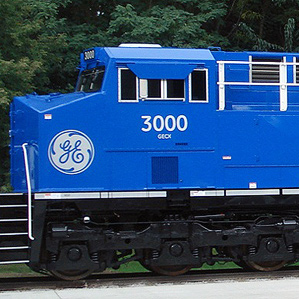Cleaner Long-Haul Engines Guzzle Diesel or Natural Gas
Technology that allows diesel engines to instead run primarily on natural gas could provide a economical way for railroads and shipping companies to shift their vast transportation systems over to natural gas.

Such a shift could lower greenhouse gas emissions, since natural gas when burned emits 15 to 20 percent less carbon dioxide than diesel. It could also save shippers money and lower the cost of shipped goods, since the natural gas boom in the United States has made natural gas far cheaper than diesel (see “Natural Gas Changes the Energy Map”).
“The economics are very powerful,” says Mark Little, director of GE Global Research. “Diesel fuel is somewhere on the order of 10 times more expensive than natural gas, per unit of energy. There’s switching going on all over the place.”
GE has developed locomotive engines that still use diesel but can also run on up to 80 percent natural gas. It recently started testing the locomotives with the freight railroad company BNSF.
Meanwhile, some trucking companies have developed similar technology for long-haul trucks. This month, for example, UPS will begin testing 10 dual-fuel trucks that use technology from Clean Air Power, a company based in Leyland, England.
Companies are likely find dual-fuel engines more tempting than natural gas–only engines, because drivers can revert to diesel if natural gas pumps aren’t available or if the price of natural gas goes back up. “The biggest concern for fleets is the issue of fuel price volatility,” says Amy Myers Jaffe, executive director for energy and sustainability at the University of California, Davis. “So there’s a lot of interest in dual fuel.”
Diesel engines can be made to run on natural gas with relatively small modifications (see “Swiss Researchers Make an 80-mpg Hybrid”). In a diesel engine, fuel and air are ignited not with a spark, as in gasoline engines, but by compressing them until they get hot enough to combust. Compression ignition, as the process is called, doesn’t work well with natural gas alone. It’s too difficult to control exactly when combustion occurs, and the natural gas can detonate—explode like a bomb—damaging the engine. In a dual-fuel engine, the problem is solved by injecting a small amount of diesel into the engine to trigger combustion.
The main addition needed to convert a diesel engine to a dual-fuel one is a system to inject the natural gas. Beyond that, it’s mostly a matter of altering the combustion timing and air-to-fuel ratio via simple adjustments. GE researchers have also designed a control system that takes into account the load being put on the engine and ambient temperatures, and adjusts the ratio of natural gas to diesel accordingly. This can be useful, for example, when running a locomotive through a tunnel, where the engine heats up to levels that can make natural gas combustion harder to control. In this case, the GE system automatically shifts to using less natural gas.
Dual-fuel technology isn’t new—it was demonstrated as early as the 1960s, says Russell Goss, program manager for dual-fuel technology at Caterpillar, which sells dual-fuel generators. But low natural gas prices have recently increased demand and led engine makers to fine-tune the technology to meet emissions requirements and displace as much diesel as possible while still maintaining performance.
The technology does have shortcomings. For one thing, most dual-fuel engines can burn no more than 65 to 80 percent natural gas. However, Westport, based in British Columbia, has developed engines that can run on up to 95 percent natural gas. They still use diesel to trigger combustion but are optimized to run on natural gas. Unlike most dual-fuel engines, they don’t run well on diesel alone. In addition to testing the dual-fuel locomotive from GE, BNSF is testing one that uses Westport technology.
For applications that require less power than large trucks and locomotives, it’s possible to use spark-ignited engines that can run on either gasoline or natural gas. Although they’re less powerful, these engines can use cheaper emissions-control equipment.
While dual-fuel technology could facilitate a transition to natural gas, a comprehensive changeover will be held up by the high cost of natural gas engines and the lack of fueling infrastructure. There are still few natural gas pumping stations, especially stations that make the liquefied natural gas (LNG) that’s best for long-distance trucking and rail.
Deep Dive
Climate change and energy
The problem with plug-in hybrids? Their drivers.
Plug-in hybrids are often sold as a transition to EVs, but new data from Europe shows we’re still underestimating the emissions they produce.
Harvard has halted its long-planned atmospheric geoengineering experiment
The decision follows years of controversy and the departure of one of the program’s key researchers.
Why hydrogen is losing the race to power cleaner cars
Batteries are dominating zero-emissions vehicles, and the fuel has better uses elsewhere.
Decarbonizing production of energy is a quick win
Clean technologies, including carbon management platforms, enable the global energy industry to play a crucial role in the transition to net zero.
Stay connected
Get the latest updates from
MIT Technology Review
Discover special offers, top stories, upcoming events, and more.